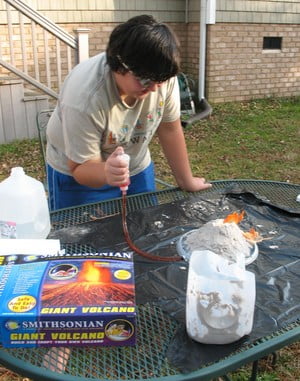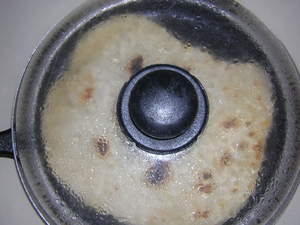Smithsonian Science Sets: Giant Volcano
Build and Erupt Your Own Volcano
(Review: Smithsonian Giant Volcano, Item #3269)
Who wouldn’t want to build and erupt a volcano in his own backyard?
Well, now you can. The Smithsonian Institution has partnered with Natural Science Industries, Ltd., to create a series of intriguing science sets that are both educational and easy to use. Here’s an overview of, and some tips on, the Giant Volcano set.
First, as with all science sets, it’s important to manage expectations. The Giant Volcano set is not going to recreate Kilauea. It will not explode, flash, rumble, sparkle or go BOOM. In other words, it will not look like the picture on the package. That said, if your child is generally enthusiastic about science experiments, the Giant Volcano will provide enough oozie, foamy possibilities to be a satisfying exercise in basic chemical reactions.
The instructional manual for the Giant Volcano is not exactly your friend, as it includes neither a master “What You’ll Need” list, nor a summary of the basic steps in the process. But take it from parents who have already blazed that trail: the basic concept of the Giant Volcano is pretty simple.
First, choose a place for the Giant Volcano that can accommodate some spills and projectiles. The instructions suggest a box with a generous layer of newspaper in the bottom. That could work, but be aware that the lava doesn’t just flow, it also can spurt—and spurt quite a distance. This is not something you’d want on the dining room ceiling. We found that an outdoor table that is not too precious works great. To protect our table and make any clean-up easier, we used a black yard waste bag under the volcano.
After getting out the pieces of the Giant Volcano set, gather the following supplies:
Vinegar (white or red)
Liquid dish soap
Food coloring (optional, but highly recommended to boost the fun factor immeasurably)
Warm tap water
Scissors
Gloves (if you or your child has a problem with plaster -type compounds on the skin)
A spoon (we used plastic)
Additional baking soda
A disposable bucket (we used an empty milk jug with the top cut off)
Once you have all your supplies, it’s time to create the Giant Volcano. Start by attaching the clear tubing to the underside of the plastic volcano form by inserting the hosing in the hole (even with the edge) and putting the tube in the notch that allows the form to stay flat on your work surface.
Mix the volcano-making compound in the disposable bucket according to directions. Basically, pour 9 ounces of warm tap water into the bucket. Mix in the packaged sand, until all sand is moistened (about five minutes). Scoop out the compound by hand and apply to the plastic volcano form, taking care not to fill in the two depressions on the side of the volcano’s cone . These should remain clear so the “lava” can flow over them and onto the sides of the cone. The lumpier the sides of the volcano, and the more varied the surface topography, the more dramatic the lava flow will be.
Allow the compound to harden. The directions state this will take about 20 minutes, but we found the touch test worked fine.
While the volcano surface is setting, make the eruption liquid in the pointy-capped bottle. Fill the bottle with vinegar. Add a few drops of dish soap and food coloring (red and yellow for the traditional volcano experience). Gently swirl into a mixture.
Spoon baking soda into the depression on top of the volcano. Attach the pointy-capped bottle to the clear plastic tubing. Make sure your child is wearing the safety goggles at this point! To cause the eruption, squeeze the bottle gently. We found that giving it a little “starter” squeeze, then a full squeeze worked best.
So long as you don’t run out of baking soda, vinegar and dish soap, the Giant Volcano can be erupted again and again. It won’t take long before your child will realize that, using different food dyes, he can make the Giant Volcano spew lava in a multitude of colors, including blue, green, purple and “gross.
The Giant Volcano surface does crack relatively easy (although this may be mostly a consequence of impatience at the hardening stage). But if not used too roughly, unlike some science sets, the Giant Volcano can provide for repeated and varied experiments. The instructional manual contains lots of nice information on volcanoes, which may lead enterprising young scientists into creative ways to try out the Giant Volcano.
Although the Giant Volcano would be quite easy to build from scratch, using simple materials around the house, that’s not easier than taking it out of the box and setting it up. Because of its easy concept, however, a child who uses the Giant Volcano set may grasp how to build his own bigger and better erupting backyard volcano. So, while the Giant Volcano does not actually spark, it may spark some ideas in your child—which, after all, is one of the things that makes science sets so wonderful.
All in all, the Smithsonian Giant Volcano set is an easy and fun project for kids and parents alike. It demonstrates several basic chemistry and physics concepts, all the while allowing for the user to creatively individualize the experience.
Sources:
Natural Science Industries, Ltd.
Hawaii Volcano Observatory, “Kilauea—Perhaps the World’s Most Active Volcano,” U.S. Geological Survey.




